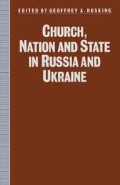Abstract
The Gorbachev period, with its glasnost’ and frenetic liberalisations, has witnessed a more open airing of religious themes than had been possible under previous Soviet leaderships. As shall be seen, however, no Soviet writer or filmmaker can openly admit to being religious, and there remain religious subjects—for example, the figure of Jesus Christ—which can be discussed only with considerable caution. This paper examines the spheres of literature and film over the first three and a half years of the Gorbachev ‘thaw’ and seeks to determine what changes have occurred in how these two media have been treating religious themes.
Access this chapter
Tax calculation will be finalised at checkout
Purchases are for personal use only
Preview
Unable to display preview. Download preview PDF.
Notes
I. Kryvelev, ‘Koketnichaia s bozhen’koi’, Komsomol’skaia pravda, 30 July 1986, p. 4.
For an excellent discussion of Lenin’s views on religion, see Bohdan R. Bociurkiw, ‘Lenin and Religion’ in Leonard Schapiro and Peter Reddaway (eds), Lenin: The Man, the Theorist, the Leader, a Reappraisal (New York: 1967) pp. 107–34.
Chingiz Aitmatov, ‘Plakha, Roman’ in Novyi mir (1986) no. 6, pp. 7–69; (1986) no. 8, pp. 90–148; and (1986) no. 9, pp. 6–64.
See also Katerina Clark, ‘The Executioner’s Block: A Novel of the Thaw’, Times Literary Supplement, 26 June 1987, p. 696.
See Ales’ Adamovich, ‘Urok pravdy’, Literaturnaia gazeta, 17 March 1986, p. 5;
S. Lominadze in Voprosy literatury (1987) no. 3, p. 35.
See the interview with Sergei Zalygin, editor-in-chief of Novyi mir, in Literaturnaia gazeta, 26 August 1987, p. 7.
See Kuznetsov’s comments in Literaturnaia gazeta, 6 May 1987, p. 2.
S. Kaltakhchian, ‘Ne vera, a znaniia’ in Komsomol’skaia pravda, 10 December 1986, p. 2.
Andrei Nuikin, ‘Novoe bogoiskatel’stvo i starve dogmy’, Novyi mir (1987) no. 4, pp. 245–59.
N. Zorkaia, ‘Dorogoi, kotoraia vedet k Khramu’, Iskusstvo kino (1987) no. 5, p. 48.
Shirley Maclaine, Dancing in the Light (New York: 1985).
Cited from an excellent review of the film by Peter Green, ‘Apocalypse and Sacrifice’, Sight and Sound (Spring 1987) p. 112.
Dan Yakir, ‘From Russia to Hollywood’, Boston Globe, 11 January 1986.
On this congress, see John B. Dunlop, ‘Soviet Cultural Politics’, Problems of Communism (November–December 1987) pp. 36–8.
Editor information
Editors and Affiliations
Copyright information
© 1991 School of Slavonic and East European Studies
About this chapter
Cite this chapter
Dunlop, J.B. (1991). Religious Currents in Contemporary Soviet Literature and Film. In: Hosking, G.A. (eds) Church, Nation and State in Russia and Ukraine. Studies in Russia and East Europe. Palgrave Macmillan, London. https://doi.org/10.1007/978-1-349-21566-9_19
Download citation
DOI: https://doi.org/10.1007/978-1-349-21566-9_19
Publisher Name: Palgrave Macmillan, London
Print ISBN: 978-1-349-21568-3
Online ISBN: 978-1-349-21566-9
eBook Packages: Palgrave Religion & Philosophy CollectionPhilosophy and Religion (R0)

